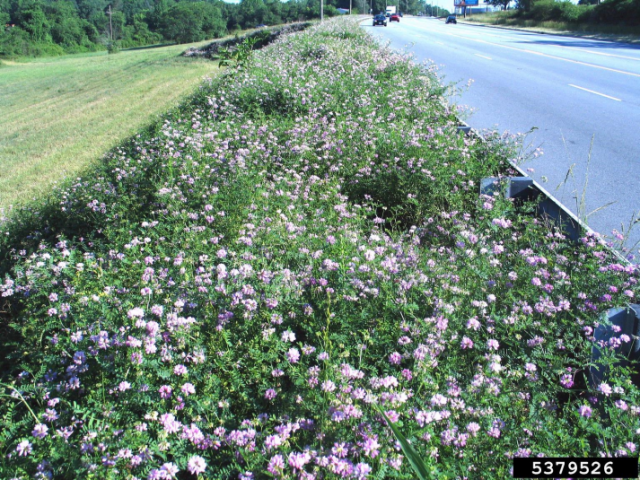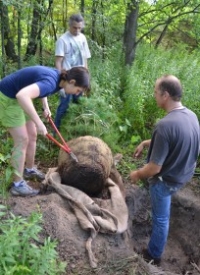Native and Non-native
Plants can be one of two things, native or non-native to an area. Native meaning it is historically, pre-European settlement, found in a given region. Non-native refers to a plant that isn't historically found in a given region. Both of these terms can be used broadly when talking about a continent, or specifically to a region of a state. An example of this would be: "Acer negundo, Box-elder, is native to Southern Wisconsin and throughout Central and Eastern United States."
 A plant can be native to one part of the country, or state, and non-native to the other. This usually has to do with climate conditions such as length of growing season, amount of rainfall per year, elevation of topography, and soil type. The vegetation of Wisconsin map shows the different habitats pretty well. A good example of this is Balsam Fir (Abies balsamea). It is native to northern Wisconsin, but not native to southern Wisconsin because the growing conditions don't favor it.
A plant can be native to one part of the country, or state, and non-native to the other. This usually has to do with climate conditions such as length of growing season, amount of rainfall per year, elevation of topography, and soil type. The vegetation of Wisconsin map shows the different habitats pretty well. A good example of this is Balsam Fir (Abies balsamea). It is native to northern Wisconsin, but not native to southern Wisconsin because the growing conditions don't favor it.
Non-native is commonly used to describe a plant from another country; the term non-native can also describe a plant from the same country (North America), but a different region of the country. For example, we have different species of sumac native to Wisconsin (Staghorn Sumac, Rhus typhina) and some non-native to Wisconsin, but native to Western United States where it is much drier (Skunkbush Sumac, Rhus trilobata). Common Buckthorn (Rhus cathartica), Reed Canary Grass (Phalaris arundinacea), Garlic Mustard (Alliaria petiolata) are all non-native plants from Eurasia, which leads us to the next section of terms that describes these plants.
Invasive Plants
Invasive plants are any plant that that out-competes other plants, that is, off-setting the balance of the ecosystem. The term invasive is most commonly used when describing non-native plants from other countries. A majority of these plants were introduced to North America during the time of European settlement. Typically, these plants were brought over on purpose for edible/medicinal use or ornamental use (some plants were also brought over on accident via shipping vessels).
Some examples of plants that were brought to North America for ornamental purposes are Dame's Rocket (Hesperis matronalis), Japanese Knotweed (Fallopia japonica), and Woodland Forget-me-not (Myosotis sylvatica). Examples of edible/medicinal plants are Common Burdock (Arctium minus), Dandelion (Taraxacum officinale), and Common St. John's Wort (Hypericum perforatum).
Plants that are invasive to an ecosystem usually have a combination of these characteristics in common: they spread vegetatively or prolifically by seed, are allopathic to other plants and/or lack insect species that feed on them. The result of this usually is a monoculture of a single species in an area and greatly off-balance the ecosystem. Once these plants are established in an area, it can take years (or even decades!) of vigorous invasive management to rid an area of an invasive plant.
 In some cases, non-native invasive plants were used by local and state government entities for erosion control. Purple Crown Vetch (Securigera varia) and Red/White Clover (Trifolium spp.) are two examples of this. They both were/are used to stabilize the ground after a disturbance such as road construction or washouts.
In some cases, non-native invasive plants were used by local and state government entities for erosion control. Purple Crown Vetch (Securigera varia) and Red/White Clover (Trifolium spp.) are two examples of this. They both were/are used to stabilize the ground after a disturbance such as road construction or washouts.
Special Monitoring Statuses
When a native species becomes rare to an area due to loss of habitat, invasion of a non-native species, or whatever the case, it is given a careful monitoring status and designation by the state and/or federal levels. The various statuses can be thought of as a spectrum from "extinct" to "special concern."
"Extinction" refers to the end of existence of an organism (in our case a plant), or a group of an organism. Most common species of a certain genus will go extinct and not an entire genus', though that is not impossible. Before a specific species goes extinct, it's not uncommon for it to lose the ability to multiply and produce viable seed for many years before extinction actually happens. Species can also be "regionally extinct" where it no longer is found in an area that historically was present.
An example of an extinct species that was once found in this area (Lake Calumet, Chicago, IL) is Thismia americana, which is a genus most commonly found in East and Southeast Asia with only one species native to North America. Thismia americana was a flowering plant found in the wetlands around Lake Calumet and was known to be extinct since 1916 due to extensive altering of habitat by industrial development.
 Next on the spectrum, and less extreme, is the term "endangered." These species are those that are threatened by extinction throughout all or a significant portion of its natural range; an example of a plant that is endangered in Wisconsin is Round-headed Bush Clover (Lespedeza leptostachya).
Next on the spectrum, and less extreme, is the term "endangered." These species are those that are threatened by extinction throughout all or a significant portion of its natural range; an example of a plant that is endangered in Wisconsin is Round-headed Bush Clover (Lespedeza leptostachya).
Next, and even less extreme, are "threatened" species. These plants are likely to become endangered in the foreseeable future throughout all or a significant portion of its natural range; an example for this would be Pale Purple Coneflower (Echinacea pallida).
Last on the spectrum are species that are of "special concern." These species, though not endangered or threatened, are extremely uncommon or have a unique or highly specific habitat requirement to live. Species that are on the periphery of their natural range, and not considered threatened, may also be included in this list.
Each of these designations is protected, both by the state and federally, under law and may carry criminal prosecution if violated. If you want to reference the list of Endangered and Threatened species in Wisconsin, click here.
Get Involved!
If you want to learn more about native versus non-native plant species, come volunteer at any one of our branches for ROOT!





